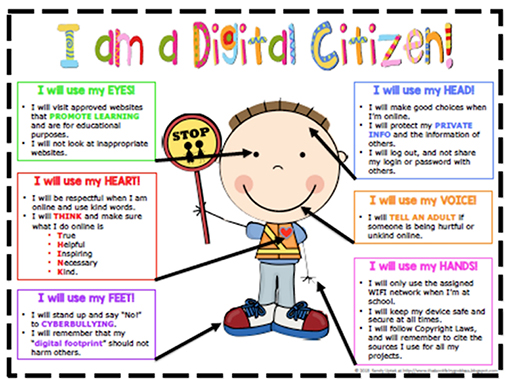Use 'Print preview' to check the number of pages and printer settings.
Print functionality varies between browsers.
Printable page generated Saturday, 4 May 2024, 9:38 PM
The Internet and the web
Introduction
- The Internet is a collection of interconnected computers located throughout the world. These computers come in many forms, most obviously the traditional PC, but also include tablet computers, smart phones and smart home devices such as televisions.
- Many domestic and commercial devices that are required to share information are now doing so via the Internet. This is known as the Internet of Everything (IoE).
- Some examples of the IoE are:
- Controlling the lights and heating in your house from a smart phone when you are on holiday.
- Viewing your security/cat flap camera from your smart phone when you are at work or school.
- Traffic lights automatically detecting an approaching ambulance and communicating among themselves to provide a clear path to the hospital.
- Doctors monitoring a patient’s heart rate remotely via wearable technology.
- Whenever you are using a computing device to access the Internet, you have actually become a part of it!
1 The Internet at home
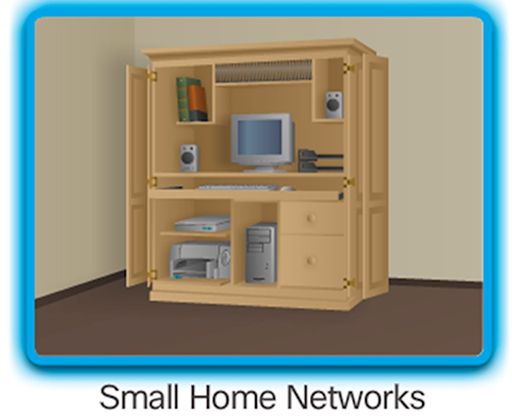
- Many people now have computers at home (remember, tablets and smart phones can be considered as computers), which communicate over a network.
- The network connections that link the device can be either wired or wireless.
- In order for these devices to access the Internet, you need to sign up with an Internet service provider (ISP), such as BT, Virgin Media, Sky or TalkTalk.
- Your service provider normally provides a home router, which your devices can connect to within your home using wires or wirelessly.
- The home router can connect to the ISP via a variety of methods, such as cable system, traditional phone wires or wirelessly. The connection method used will depend on the ISP you have chosen.
- Due to the size of your home network, it is referred to as a Local Area Network (LAN), which means it is used to connect together devices that are physically close together.
Activity: Computing devices
List all of the computing devices within your home network.
Answer
At home you might have: a personal computer, laptop, printer, smart phone, tablet, smart TV, personal video recorder, alarm system, security camera and a home router.
2 Local Area Networks – small office/home office
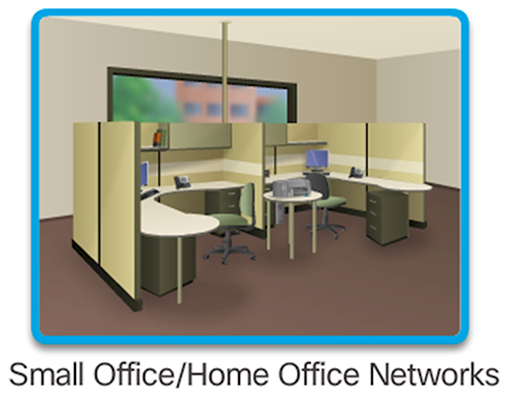
- Many people have jobs that can be done from home via the Internet. This requires them to use a network to connect together the computing devices needed to do their work.
- Many businesses are small in size (with no more than 10 people working for them), and also require a network to connect together their employee’s computing devices.
- These home/office networks are still considered to be LANs, but due to their small size are often referred to as Small Office Home Office (SOHO) networks.
- Depending on the purpose of the small business, SOHO networks often contain more specialised computing devices and software than a home LAN, but still need to be connected to the Internet via an ISP.
3 Local Area Networks – business
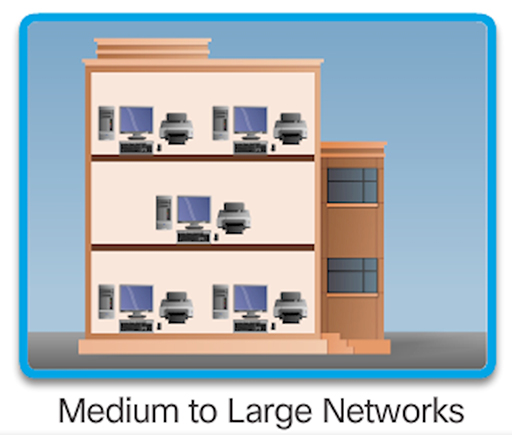
- Larger businesses may have a great many network-connected devices due to the large number of staff they employ. Their network is still considered to be a LAN if the devices are located within the same building or on the same site.
- A business LAN will probably contain many specialist devices not typically found in SOHO networks, such as:
- Internet telephones
- servers
- security devices
- Servers are computers that can provide services for those who use the LAN. For example, a file server allows LAN users to share files (documents, video and software).
- Security devices are special network hardware, designed to protect the network from attack.
4 Wide Area Networks
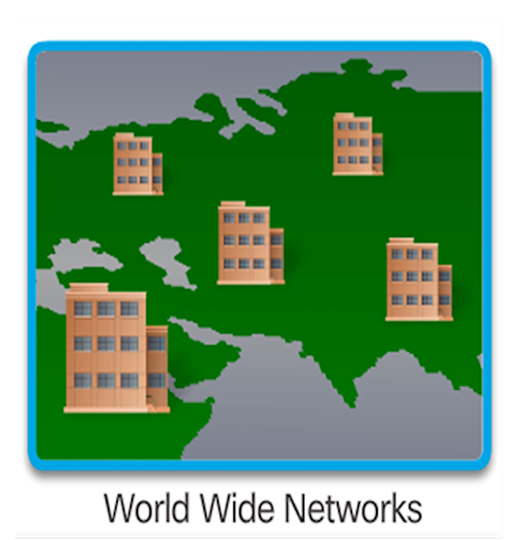
- Very large organisations require the use of multiple LANs to allow their staff to do business in different parts of a country, or even in other countries.
- The individual networks must be connected together to allow the staff to communicate and share information. This creates a type of network called a Wide Area Network (WAN).
- Once again it is the responsibility of ISPs to provide the connections between the LANs, although the devices involved will be far more powerful than those used in SOHO networks.
- Some organisations may even create a WAN using their own devices.
- Because a WAN is a collection of LANs connected together over large distances, the Internet itself is considered to be the largest WAN in existence.
5 Wireless networks
- There are many different wireless technologies available for use within networks. Most current wireless technologies use radio frequencies to transmit data between devices.
- The main difference between the various types of wireless technology is the amount of data that it can send (data rate) and how far the data can travel (range).
- The wireless technologies available for LANs are:
| Wireless technology | Data rate | Data range |
|---|---|---|
| bluetooth | low | short, medium |
| WiFi | medium | medium |
| Zigbee | low | medium |
- Bluetooth and Zigbee are designed to allow computing devices to be paired so that they will operate together. For example, Bluetooth can be used to connect headphones to a smartphone, whereas Zigbee is commonly used to connect household devices or sensors (motion, temperature, etc.) to a central controller.
- WiFi is commonly used to connect computing devices within a home, SOHO or business LAN to allow them to access local and Internet resources.
- A home, SOHO or business usually has the ability to support both wired and wireless WiFi connections. If you have access to your home router, examine it to see whether it can support wired connections.
- To provide Internet access for customers, many businesses provide free WiFi, and it is becoming increasingly common for local councils to provide free WiFi in city centres.
- Bluetooth has different implementations. For example, it can also be used for data, somewhat like WiFi – you can have a local Personal Area Network (PAN) or connect over greater distances. Some retailers connect to your smartphone’s Bluetooth when you enter their shop.
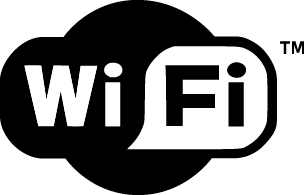
6 Mobile wireless
- Mobile phones also use radio frequencies to connect both voice and data signals to the mobile provider’s network. The technology used is different to that used in LANs, but can typically support quite high data rates over a reasonable range, typically a few kilometres.
- The different types of technology are identified by ‘generations’ (e.g. 2G, 3G and 4G), with data rates improving with each generation.
- When you travel and use your smart phone to access the Internet, the mobile phone company provides the same connection service as your ISP when you are at home, but using different technology.
7 The Internet
- As we have seen, the Internet is a collection of connected networks that cooperate in order to exchange data. It uses a range of different technologies and is not owned by any single organisation.
- When you access the Internet from your home, all the content that you interact with is located on servers around the world that are themselves connected to the Internet. This is true when you are using social media, playing an online game (like Minecraft), shopping, using email or accessing educational resources.
- When using the World Wide Web (WWW) via a web browser, you are accessing the Internet, but remember that the WWW is just one of the services that is accessible via the Internet.
- Watch the following video for more information about the basic operation of web and email services.
8 Online behaviour
- The Internet is an amazing way of performing many useful and fun activities:
- searching for information and learning
- playing games
- keeping in touch with friends and family
- sharing ideas and pictures
- making new friends.
- But you must remember that the Internet provides a gateway that is open to both you and millions of other people around the world. There is no guarantee that other users of the Internet will be friendly, or that they won’t try to trick you for their own benefit.
- Using the Internet exposes you to risks that you need to be aware of in order to safely use it for your enjoyment. Watch the following video to learn more about these risks:
- Parents have always told children to be careful around strangers, and this is still good advice when using the Internet. You must also remember that once you have made information or pictures available online, it is very difficult to stop them from being shared.
- It is therefore very important to THINK about what you are posting online before you post it:
- T – is it True?
- H – is it Hurtful?
- I – is it Illegal?
- N – is it Necessary?
- K – is it Kind?
- To enjoy your time online, and to make it a pleasant place for your friends and family, you need to be a good digital citizen:
Activity: Using the Internet
When using the Internet to do the following things, what questions should you consider?
| What should you consider when… | Answer |
|---|---|
| … searching for information and learning? | |
| … playing games? | |
| … keeping in touch/sharing ideas and pictures? | |
| … making new friends? |
Answer
Read the table below for suggested questions you might have thought of.
| What should you consider when… | Answer |
|---|---|
| … searching for information and learning? | Is the information you found true? Who wrote it? Is it an opinion or a fact? |
| … playing games? | Who are you playing the game with? Do you know them offline (for example, from school) or have you met them online? Are the games appropriate? Some may be designed for adults and could be upsetting to children. |
| … keeping in touch/sharing ideas and pictures? | What information are you giving other people? What can they do with it? Could the information/pictures be used to embarrass you or other people? |
| … making new friends? | Do you really know who you are talking to online? It is very easy to pretend to be someone you are not online. |
9 Activities
Activity: Making a positive digital footprint
Part 1
It is as important to think about your safety online as it is in the real world. Watch the video, ‘Newsround – Caught in the Web’ and complete the questions below.
Part 2
A good digital citizen should leave a positive digital footprint. Now that you have considered the characters in the video, think about three ways in which you have used the Internet in the past and what you could have done differently. Complete the table below.
| What I did | What I could have done differently |
|---|---|
Activity: Extended classroom activities
- Come up with a plan of how to remember your passwords or store them securely.
- Discuss in the class how much time you spend and what you do on the Internet. Are you missing out on real life?
- What dangers could you be in if you lie about your age online?
Activity: Drama for Internet safety
Take a look at the activity provided by Childnet International about sexting. The pact includes a 25-minute play script and lesson plans to explore the consequences of creating and sending indecent images.
Act out the scenario with different children with different characteristics based on the role cards. Ask students to discuss why they did things in a certain way.
10 Additional resources
For more information, take a look at the following resources.
- Internet for Beginners
- BBC Bitesize - What is the World Wide Web
- How the Internet Works
- Communications and Networks Unplugged, by the Digital Schoolhouse. Explore the differences between the Internet and the World Wide Web. You can also register with Digital Schoolhouse for free to access full resources.
11 End of course quiz
Now it’s time to test what you’ve learned in a quiz.
12 Acknowledgements
Grateful acknowledgement is made to the following sources:
Figure 1: Cisco
Figure 2: Cisco
Figure 3: Cisco
Figure 4: Cisco
Figure 6: I am a Digital Citizen! Sandy Liptak found on lessonsbysandy.com.
Every effort has been made to contact copyright holders. If any have been inadvertently overlooked the publishers will be pleased to make the necessary arrangements at the first opportunity.
